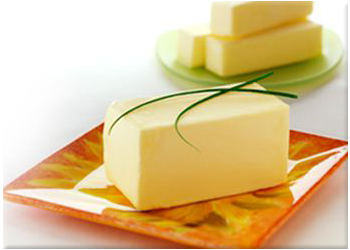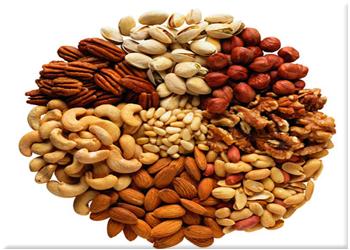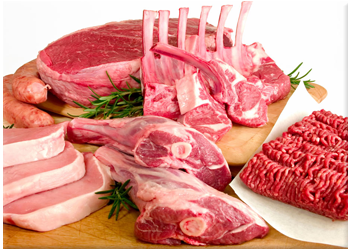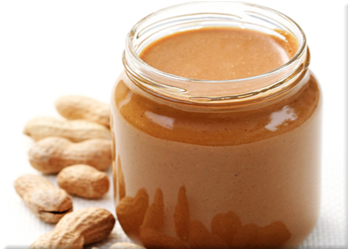FAT
The term lipid is applied to a group of naturally occurring substances characterized by their insolubility in water and their solubility in such “fat solvent” as ether, chloroform, boiling alcohol and benzene. Chemically, the lipids are either esters of fatty acids or substances capable of forming such esters. The word ‘lipid’ is used when discussing the metabolism of fats in the body whereas the term ‘fats’ is used the fatty component of foods and diets.
 |
Fat is a concentrated source of energy stored by our bodies as reserve fuel. Fat is an important component of diet and serves a number of functions in the body.
Fats like carbohydrates are composed of the three elements carbon, hydrogen and oxygen. The lower amount of oxygen in relation to the other two elements results in fat being a more concentrated source of energy than carbohydrates.
Lipids are very wide spread in nature among all vegetable and animal matter. Some compounds of this group, such as phosphatide and sterols are found in all living cells where, with the proteins and carbohydrates they form an essential part of the colloidal complex of protoplasm. Complex lipids are also found in large quantities in brain and nervous tissues. |
CLASSIFICATION
Simple Lipids
These are esters of fatty acids with certain alcohols. They are usually further classified according to the nature of the alcohols.
Fats and oils
These are esters of fatty acids and glycerol. They can be triacylglcerols diacyl glycerol or monoacylglcerols.
Waxes
These are esters of fatty acid with long chain aliphatic alcohols or with cyclic alcohols. These may be subdivided into true waxes, cholesterol esters, vitamin A and its carotenoid esters and vitamin D esters.
Compound Lipids
The compound lipids are esters of fatty acids which on hydrolysis yield other substances in addition to fatty acids and an alcohol.
Phospholipids
These are lipids which on hydrolysis yield fatty acids, phosphoric acid, an alcohol and a nitrogenous base e.g., lecithin, cephalin and sphingomycelin.
Glycolipids
Glycolipids can be subclassified into cerebrosides and gangliosides. They are so named because they have a carbohydrate component within their structure like phospholipids, their physiological role in principally structured, contributing little as an energy source. They occur in the medullary sheaths of nerves and in brain tissue, particularly the white matter.
A cerebroside is characterized by the linking of ceramide to monosaccharide unit such as glucose or galactose.
Gangliosides resemble cerebrosides except that the single monosaccharide unit of the cerebroside is replaced by an oligosaccharide. Gangliosides provide the carbohydrate determinants of the human blood groups A, B and O.
Aminolipids, sulpholipids
The sulpholipids yield sulphuric acid on hydrolysis. Similar to cerebrosides except that sulphuric acid is present as cerebronic acid ester.
Lipoproteins
These compounds found in mammalian plasma are composed of lipid material bound to proteins. The lipid mostly consists of cholesterol esters. Phospholipids containing principally stearic, palmitic and oleic acids although palmitoleic, linoleic and arachidonic acids have been identified.
Derived Lipids
These are substances liberated during hydrolysis of simple and compound lipids which still retain the properties of lipids.
Cholesterol
In nature sterol, occurs in the free state and as esters with fatty acids. Sterols are classified as: (i) Animal sterols e.g., cholesterol, (ii) Plant sterols, e.g., phytosterol and (iii) Mycosterol, eg., ergosterol.
Cholesterol occurs in all animal and human tissues. The white matter of the brain contains about 14 per cent cholesterol while the grey matter contains 6 per cent on dry basis. Large amounts of cholesterol are also present in sebum secreted by the sebaceous glands.
Cholesterol serves as a precursor for the formation of bile acids. It is present in cell membranes and essential for maintaining the membranes in good condition. It serves as a precursor for the formation of some steroid hormones such as oestrogens, androgens and progesterone. It is also essential for the synthesis of adrenocortical hormones. Cholesterol is a waxy substance found only in foods from animal origin like milk, milk products, meat, fish, egg and poultry. While our bodies manufacture certain amounts of cholesterol, they are incapable of removing excess present in the blood.
Extra cholesterol gets deposited on the walls of blood vessels causing them to thicken and overtime, get blocked. Cholesterol travels through our bodies in the form of tiny droplets in the blood-HDL (high density lipoprotein) and LDL (low density lipoprotein). HDL is the good cholesterol that does not get deposited on the walls of our blood vessels while LDL, the bad cholesterol does. If this happens to the vessels supplying blood to the heart, the risk of a heart attack increases.
The good and the bad
-
Saturated fat
-
Unsaturated fat
Saturated fat like butter, ghee, vanaspathi, lard, coconut oil, etc., is solid at room temperature and considered bad fat. When eaten in large quantities, it too tends to solidify in the blood vessels and cause blockages that eventually lead to heart diseases. In addition, too much saturated fat in the blood can cause our bodies to produce more cholesterol and more blockages. For this reason, foods low in cholesterol but high in saturated fat are equally dangerous and therefore avoidable.
Unsaturated fat is good fat known to reduce cholesterol in the blood. Liquid at room temperature, mostly cooking oils (sunflower, safflower, canola, mustard, groundnut, olive, gingelly oils, etc.,) and fish contain unsaturated fat. This fat is preferable as it is known to protect the heart by raising the level of good cholesterol (HDL) in the blood.
Trans-saturated fat is a type of unsaturated fat found in most processed foods to increase their shelf life and enhance their texture. Although unsaturated, this fat is harmful and known to raise bad cholesterol (LDL) and decrease the good cholesterol (HDL) levels in our. Packaged cookies, crackers, French fries, fried chicken and doughnuts are major sources of trans-saturated fat.
The important natural fatty acids and their occurrence
| Fatty acids |
C atoms and double bonds |
Occurrence |
| Saturated acids |
| Short chain |
| Butyric acid |
C4 : O |
Butter |
| Caproic acid |
C6 : O |
Butter, Coconut oil |
| Caprylic acid |
C8 : O |
Butter, Coconut oil |
| Medium chain |
| Capric acid |
C10 : O |
Butter, Coconut oil |
| Lauric acid |
C12 : O |
Butter, Coconut oil |
| Myristic acid |
C14 : O |
Butter, vegetable foods |
| Long chain |
| Palmitic acid |
C16 : O |
Most vegetable and animal fats |
| Stearic acid |
C18 : O |
Most vegetable and animal fats |
| Arachidic acid |
C20 : O |
Butter, lard, peanut oil |
| Behanic acid |
C22 : O |
Vegetable oils |
| Unsaturated fatty acids |
| Monounsaturated fatty acids |
| Palmitoleic acid |
C16 : 1 |
Oilve oil, fish oil, beef fat |
| Oleic acid |
C18 : 1 |
Oilve oil, Canola oil |
| Erucic acid |
C22 : 1 |
Rape seed oil, Canola oil |
| Polyunsaturated fatty acids |
| Linoleic acid |
C18 : 2 (n-6) |
Vegetable seed oils (Safflower, corn, soyabean, cotton seed) |
| a-Linolenic acid |
C18 : 3(n-3) |
Vegetable seed oils (soyabean oil) |
| Arachidonic acid |
C20 : 4(n-6) |
Fat and phosphatide fractions of animal tissues particularly liver; land, meat |
| Eicosapentaenoic acid |
C20 : 5 (n-3) |
Fish oils, Shell fish |
| Docosahexaenoic acid |
C22 : 6 (n-3) |
Fish oils, shell fish |
Medium Chain Fatty Acids
These are saturated fatty acids with a chain length between 10 and 14 carbons. They are found in Medium Chain Triglycerides (MCT). They are short enough to be water soluble, require less bile salts for solubilisation, are not re-esterified in the enterocyte and are transported as free fatty acid, bound to albumin, through the portal system. Because the portal blood flow rate is about 250 times faster than lymph flow, MCT are digested quickly and are not likely to be affected by intestinal factors that inhibit fat absorption. Medium chain fatty acids are not stored in adipose tissue but are oxidized to acetic acid. Natural MCT occur in milk fat, coconut oil and palm kernel oil. Clinically, MCT oil is used for patients with fat malabsorption or in catabolic states such as acquired immuno deficiency syndrome and cancer.
THE ROLE OF FAT IN THE BODY
-
Energy reserve - Fat is the primary form in which energy is stored in the body. One pound (454 g) of stored fat represents 3500 kcal of stored energy. Some fat can be stored within most cells but the body also contains large numbers of specialized fat cells (adipocytes) within fat (adipose) tissue, whose main function is the storage of fat. The number of adipocytes within the body appears to be genetically determined but fat cells can increase in size at any time to accommodate increased stores of fat resulting in obesity.
-
Within the cells of adipose tissue, fat is stored to the extent of 90 percent largely in the form of globules of triglycerides. These may be the result of the resynthesis of triglyceride from glycerol and fatty acids. When dietary supplies of fat are in excess of bodily requirements or when there is excess carbohydrate or protein resynthesis of triglyceride occurs
-
Specific long chain omega-6 and omega-3 unsaturated fatty acids also act as the precursors of a range of hormone like substances, the eicosanoids, involved in the regulation of a wide variety of processes in the body.
-
Eicosanoids perform many functions, including the regulation of blood pressure, the control of important aspects of the reproductive cycle, the stimulation of pain and fever and the induction of blood clotting.
-
Insulator - Deposits of fat beneath the skin known as the subcutaneous fat, serve as an insulating material for the body and is effective a preventing heat loss. A certain minimal layer of fat is desirable, but too thick, a layer slows down heat loss considerably in hot weather, causing discomfort.
-
Protector - Deposits of fat surround certain vital organs, such as the kidneys and heart, serving to hold them in position and protect them from physical shock. These protective deposits are the last to be drawn on for energy supplies when energy in the diet is inadequate.
THE ROLE OF FAT IN THE DIET
- Satiety value - Fat tends to leave the stomach relatively slowly. It can still be released from the stomach for up to 3.5 hours after a meal with the precise time depending on the size and composition of the meal. This prolonged stay in the stomach helps to delay the onset of hunger pangs and contributes to a feeling of satiety after a meal. Due to this, moderate fat reducing diets are currently considered more successful in weight control than vary fat diets.
- Carrier of fat soluble vitamins -Dietary fat serves as a carrier for vitamins A, D, E and K. Also fat at a level of at least 10 per cent of total energy intake appears to be required for the absorption of vitamin A precursors from nonfat sources such as carrots. Anything that interferes with absorption or use of fat such as obstruction of bile duct depresses the supply of fat soluble vitamins to the body.
- Palatability - The presence of fat in food or its addition to food is responsible for much of the texture and flavour of food. The marbling of fat throughout the lean muscle of a steak contributes greatly to its tenderness for the flavours and aromas of foods are soluble in fat so that fat tends to carry these flavours and aromas and mix them throughout the food as a whole.
SOURCES
Fat in the diet can be of two kinds, the visible and invisible fat.
The visible fats are those derived from animal fats like butter, ghee which are solid fats and those derived from vegetable fats like groundnut, mustard, coconut, safflower, till which are liquid fats. Saturated fatty acids predominate in animal fats and unsaturated fatty acids dominate in vegetable oils. Animal fats like ghee and butter contain vitamin A and D.
The invisible fats are those virtually all foods contain some amount of hidden fat. Rice, wheat, ragi, dhal, vegetables and fruit are foods that have hidden fat in very negligible amounts thus making them a healthier option.
Nuts and oil seeds are excellent sources of fat. Fruits and vegetables are poor sources of fat, avocado being an exception.
Fat content of foods
| Name of Food stuff |
Fat g/100 g |
| Ghee and oil |
100 |
| Butter |
81 |
| Coconut dry |
62 |
| Cashew nut |
40 |
| Groundnut |
25 |
| Cheese |
23 |
| Avocado |
23 |
| Soya bean |
19 |
| Egg hen |
13 |
REQUIREMENT
The minimal requirement of visible fat to meet EFA requirements is in the range of 15-25 g/day for different physiological groups. One is the role of excessive intake of fat in diet in increasing the level of cholesterol in blood. Amount greater than 80g/day, may lead to an increase in blood cholesterol. To obtain this level of EFA in the diet, the visible fat intake should be 15-25 g/day in terms of oils like groundnut.
TIPS TO REMEMBER
-
Take just enough fat.
-
Use more than one source of cooking oil
-
Limit use of ghee, butter and vanaspathi.
-
Eat foods rich in α-linolenic acid (legumes, green leafy vegetables, fenugreek and mustard seeds).
-
Eat fish more frequently than meat, poultry and limit/avoid organ meats (liver, kidney brain, etc).
Source
Vijayapushpam et al. 2008, Fat: Human Health. NIN, Hyderabad.
http://myloupe.com/disp_thumb_images/4078/thumbnail/373157.jpg
http://www.mediterranean-food-recipes.com/images/ghee-picture.jpg
http://img165.imageshack.us/img165/1246/academiabarillagourmeto0eq.jpg
http://www.germes-online.com/direct/dbimage/50292137/Cocoa_Butter.jpg |




